This is a large file it contains:-
-
Cast lists of all seven recordings reviewed plus one
video
-
An introductory article about Manon Lescaut
-
Act by act synopses with integrated reviews
-
Conclusions
Click here to see a general article
on the operas of Puccini
This is the third article in a series where all Puccini operas are discussed
and leading recordings compared. Already covered:
La bohème and
La rondine.
Suggested links: The article
Abbé Prévost's Manon Lescaut
Manon - opera by Massenet
- review of Alagna/Gheorghiu recording
Manon -
ballet by Kenneth MacMillan video reviewed.
Cast Lists and Recordings References
The Jonel Perlea/Jussi Bjoerling 1954 recording
Manon Lescaut…………………………..Licia
Albanese
Des Grieux………………………………Jussi
Bjoerling
Lesaut……………………………………Robert
Merrill
Geronte Di Ravoir……………………….Franco
Calabrese
Edmondo………………………………
Enrico Campi
Rome Opera Orchestra and Chorus conducted by Jonel Perlea
 RCA Victor Gold Seal
GD60573 (Mono) 2 CDs [119:02]
RCA Victor Gold Seal
GD60573 (Mono) 2 CDs [119:02]
We understand this is now deleted (6/02)
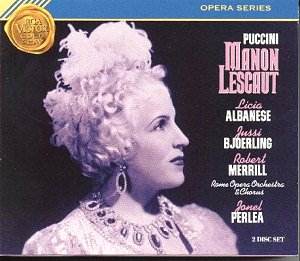
The Tullio Serafin/Maria Callas 1959 Recording
Manon Lescaut……………………… Maria
Callas
Des Grieux………………………… Giuseppe
di Stefano
Lescaut……………………………….
Giulio Fioravanti
Geronte di Ravoir…………………….Franco
Calabrese
Edmondo……………………………
Dino Formichini
Opera and Chorus of La Scala Milan conducted by Tullio Serafin
 EMI CDS5 56301 2 (Mono)
2 CDs
[120:37]
EMI CDS5 56301 2 (Mono)
2 CDs
[120:37]
Crotchet
£25
Amazon
UK £27.99
Amazon
US $31.32
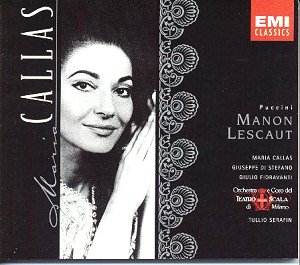
The Bruno Bartoletti/Placido Domingo/Montserrat Caballé 1972
recording
Manon Lescaut
………………………Montserrat
Caballé
Chevalier Des Grieux……………… Placido Domingo
Lescaut……………………………….Vicente
Sardinero
Geronte di Ravoir…………………… Noël
Mangin
Edmondo……………………………..Robert
Tear
With Ian Partridge singing 'A Lamplighter'
Ambrosian Opera Chorus and the New Philharmonia Orchestra conducted by Bruno
Bartoletti  EMI CMS 7 64852
2 2 CDs
[116:08]
EMI CMS 7 64852
2 2 CDs
[116:08]
Crotchet
£17.00
Amazon
UK £17.99
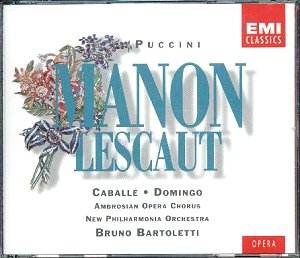
The Sinopoli/Freni/Domingo 1984 recording
Manon Lescaut……………………..Mirella
Freni
Des
Grieux………………………….Placido
Domingo
Lescaut……………………………..Renato
Bruson
Geronte di Ravoir…………………..Kurt Rydl
Edmondo……………………………Robert
Gambill
With Brigitte Fassbaender singing Un Musico
Chorus of the Royal Opera House, Covent Garden
Philharmonia Orchestra conducted by Giuseppe Sinopoli
 Deutsche Grammophon 413
893-2 2 CDs
[123:26]
Deutsche Grammophon 413
893-2 2 CDs
[123:26]
Crotchet
£25
Amazon
UK £25.99
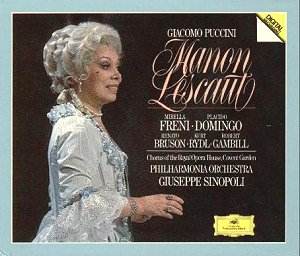
The James Levine/Freni/Pavarotti 1993 recording
Manon Lescaut …………………. .Mirella Freni
Des
Grieux………………………..Luciano
Pavarotti
Lescaut……………………………Dwayne
Croft
Geronte di Ravoir…… …………Giuseppe Taddei
Edmondo……………………… Ramon Vargas
With Cecilia Bartoli singing Un Musico
Metropolitan Opera Orchestra and Chorus conducted by James Levine
 DECCA 440 200-2
2CDs
[120:07]
DECCA 440 200-2
2CDs
[120:07]
Crotchet
£25
Amazon
UK £25.99
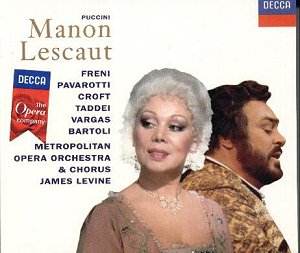
The Ricacardo Muti/José Cura/Maria Guleghina 1998 recording
Manon Lescaut…………………..Maria Guleghina
Des
Grieux………………………José
Gura
Lescaut………………………… Lucio
Gallo
Geronte di Ravoir………………. Luigi Roni
Edmondo…………………… …Marco Berti
Chorus and Orchestra of La Scala Milan
Conducted by Riccardo Muti
 Deutsche Grammophon 463
186-2 2CDs
[118:44]
Deutsche Grammophon 463
186-2 2CDs
[118:44]
Crotchet
£25
Amazon
UK £25.99
Amazon
US $32.77
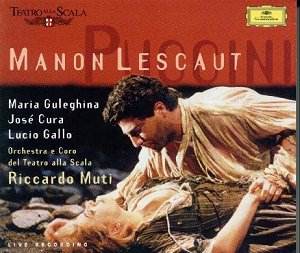
A budget recording:- The Rahbari - Naxos 1992 recording
Manon Lescaut………………….Miriam Gauci
Des Grieux………………………Kaludi
Kaludov
Lescaut………………………….Vincente
Sardinero
Geronte di Ravoir……………….Marcel Rosca
Edmondo……………………… Donald George
Brussels Radio and Television (BRT) Philharmonic Chorus and Orchestra conducted
by Alexander Rahbari
 NAXOS 8.660019-20 2CDs
[125:39]
NAXOS 8.660019-20 2CDs
[125:39]
Crotchet
£9.00
Amazon
UK £8.99
Amazon
US $14.22
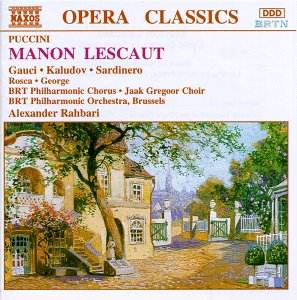
A Video Production
1997 John Eliot Gardiner/Glyndebourne Festival Opera Production
Manon Lescaut…………………Adina Nitescu
Des Grieux…………………… Patrick
Denniston
Lescaut…………………………Roberto
de Candia
Geronte di Ravoir…………… Paolo Montarsolo
Edmondo……………………… Antonello
Palombi
London Philharmonic Orchestra and Glyndebourne Chorus Conducted by John Eliot
Gardiner
 Warner Vision/NVC ARTS
0630-18647-3 [126
mins]
Warner Vision/NVC ARTS
0630-18647-3 [126
mins]
Amazon UK £14.99
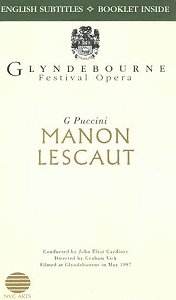
Introduction
Giacomo Puccini's Manon Lescaut (1889-92) comes, chronologically,
after his two early operas, Le Villi (The Spirits) (1883-4)
and Edgar (1885-8; rev. 1891-2), and immediately before his
'golden' trio of operas: La bohème (1893-95), Tosca
(1896-9) and Madama Butterfly (1901-03; rev. 1904-06).
"Between Edgar and his Manon, Puccini has vaulted an abyss",
reported the Corriere della Sera, after the première
of Manon Lescaut at the Teatro Regio in Turin on 1st February
1893. The report went on to say that, "Puccini's genius is truly Italian.
His song is the song of our paganism, of our artistic sensualism. It caresses
us, and becomes part of us." Many of the audience wept openly and Puccini
enjoyed an undisputed triumph, a triumph denied him in future years, for
even his next three operas, his most popular works - La bohème, Tosca
and Madama Butterfly - all had initial mixed reactions and initial failures.
But with his Manon Lescaut, Puccini found his stride and his mature
voice in a long passionate and melodic outpouring. Here, in Manon
Lescaut we hear so many of the familiar Puccini musical "fingerprints".
But it is still the work of his youth. In its music he pours a passion, often
raw and untamed that he never quite expressed again.
Manon Lescaut was three years in gestation. The libretto passed through
many hands. First to be entrusted was Leoncavallo. Puccini soon dropped him.
Reputed playwright, Marco Praga came next. He was completely inexperienced
at libretto writing. He and Ricordi (Puccini's friend and publisher) pointed
out the risk of setting the same subject as Massenet. Puccini retorted that
reading Prévost's novel had convinced him that in it he had found
'a heroine I believe in and therefore she cannot fail to win the hearts
of the public'. Speaking of Massenet he added, if he 'feels the subject
as a Frenchman, with the powder and the minuets, I shall feel it as an Italian,
with desperate passion.' - and- 'why should there not be two operas
about her [Manon]? An inconstant girl can have more than one lover.'
To Ricordi he made no bones about the fact that he, himself, would intercede
in the development of the libretto. He insisted that Praga avoid as much
as possible any duplication of scenes with Massenet and to take the novel
as his basis but at the same time not to stray into grand opera as Fontana
had done in writing Edgar. Praga being a prose writer suggested that
the poet and critic Domenico Oliva should versify his work. The collaboration
was short-lived. Praga did not approve of Puccini's alterations of his work
on dramatic grounds and withdrew leaving Oliva to work on alone. At Puccini's
suggestion Oliva sketched out a new third act that was 'dramatic, gripping
and picturesque' - the so-called embarkation Act with the roll-call of the
prostitutes developed from a passing reference in the novel to the
disembarkation in Louisiana. But soon Oliva went too. Ricordi sought
to fill the gap by recommending Giuseppe Giacosa who, in turn, recommended
another playwright Luigi Illica. After Puccini found him wanting too, Giacosa
was persuaded to collaborate with Illica to complete the work. Giacosa, Illica
and Puccini, named the 'Holy Trinity' by Ricordi went on to produce the
composer's three most popular operas that followed Manon Lescaut.
Illica's main contributions were: the injection of period atmosphere in Act
II Manon's levée with the hairdresser, music-and-dancing-masters and
probably the Madrigal; and, in Act III, the charming lamplighter's chanson
plus an extended roll-call sequence from a few to twelve.
Had Puccini stuck with Praga's original conception he would surely have been
accused of following Massenet too closely. As it turned out, the concepts
of the two operas vary considerably. In Massenet's opera we meet Manon and
Des Grieux in their love nest after the elopement from the inn at Amiens,
and before she leaves her hero for the riches of the older man. Furthermore,
Des Grieux's father's involvement is covered. All this is omitted from Puccini
and his Act II goes straight to Manon in di Ravoir's palace. The final act
in Massenet's opera takes place on the road to Le Havre while in Puccini
we are in an American desert. Massenet's opera has the advantage of showing
the gradual decline of the lovers' fortunes and it hangs together much more
successfully as a flowing and convincing narrative. Puccini's drama is
'broken-backed', less convincing, more episodic. One cannot help noticing
certain flaws. Why for instance does Lescaut, who has expended so much energy
in persuading Manon to give up love for riches, suddenly switch to helping
the lovers reunite in Act II, against his self-interest. (After what has
gone before, and his cynicism in Act II, one hardly thinks of brotherly love
or conscience, in connection with Lescaut!). Gaps like this in the transfer
from the original Prévost narrative tend to invest the Puccini drama
with an air of discomfort and disbelief that is difficult to suspend. Again
one wonders why Puccini bothers to have his lovers die out in an American
wilderness when the action could have been more conveniently located on the
road to Le Havre as in Massenet. This last Act is the weakest of the opera.
It is saved only by the intensity of the duets and arias notably Manon's
'Sola, perduta, abbandonata' which, incredibly, Puccini chose to delete after
the first performances. It was only at Toscanini's insistence that it was
reinstated for the opera's revival of 1922-23.
The dramatic structure of Acts I and II is far more successful. Act II, for
instance, is unerringly paced with the action mounting in intensity, the
more dramatic elements separated by keenly observed comic episodes such as
the opening toilette with the effete hairdresser and the equally risible
Madrigal and Minuet before the arrival of Des Grieux. From then on, the Act
is one mounting dramatic crescendo culminating in the arrest of Manon as
thief and prostitute.
Quoting Conrad Wilson writing in his book, Giacomo Puccini, 'The strong point
of Manon Lescaut lies in the wealth of fine detail with which Manon
and the other characters are portrayed - the numerous precisely-observed
touches that would become a Puccini speciality, separating him from the ordinary
composers of his period.'
When George Bernard Shaw saw the production in London in 1894, he commented,
'Puccini looks to me more like the heir of Verdi than any of his rivals.'
Shaw also noted the composer's marked symphonic tendency. Edward Greenfield
writing the programme notes for the Bartoletti recording (one of the seven
sets reviewed and compared below) writes comprehensively and convincingly
about Puccini's predilection for symphonic form in his operatic writing.
Shaw had picked up on this too, remarking that Manon Lescaut was "unmistakably
symphonic in design." In part he was implying that there were clear signs
of Wagnerian influence. The opening bars of the Intermezzo, for instance,
suggest a simplified Italian-flavoured version of the Prelude to
Tristan. And there are echoes of the 'Liebestod' elsewhere particularly
in the last act where Manon dies in the desert (and, we might assume, Des
Grieux too, bringing the similarity between the Puccini and Wagner operas
into even sharper focus).
Before the end of 1893, Manon Lescaut had been performed not only
in theatres throughout Italy but also in St. Petersburg, Madrid, Hamburg
and South America. In 1894 it reached London, Lisbon, Prague, Budapest,
Philadelphia and Mexico. In France, however, where Massenet's opus ruled,
it was not until 1906 that it was heard in Nice and not in Paris until 1910.
After the first rush of enthusiasm, while Puccini was absorbed with his
subsequent 'hits' Manon Lescaut dropped out of popularity. It was
performed only once at La Scala in 1909 until the Toscanini revival of the
early 1920s. But since then it has been performed quite regularly all over
the world gradually catching up with its 'golden trio' successors.
Ian Lace
-
Cast lists of all seven recordings reviewed plus one
video
-
An introductory article about Manon Lescaut
-
Act by act synopses with integrated reviews
-
Conclusions

